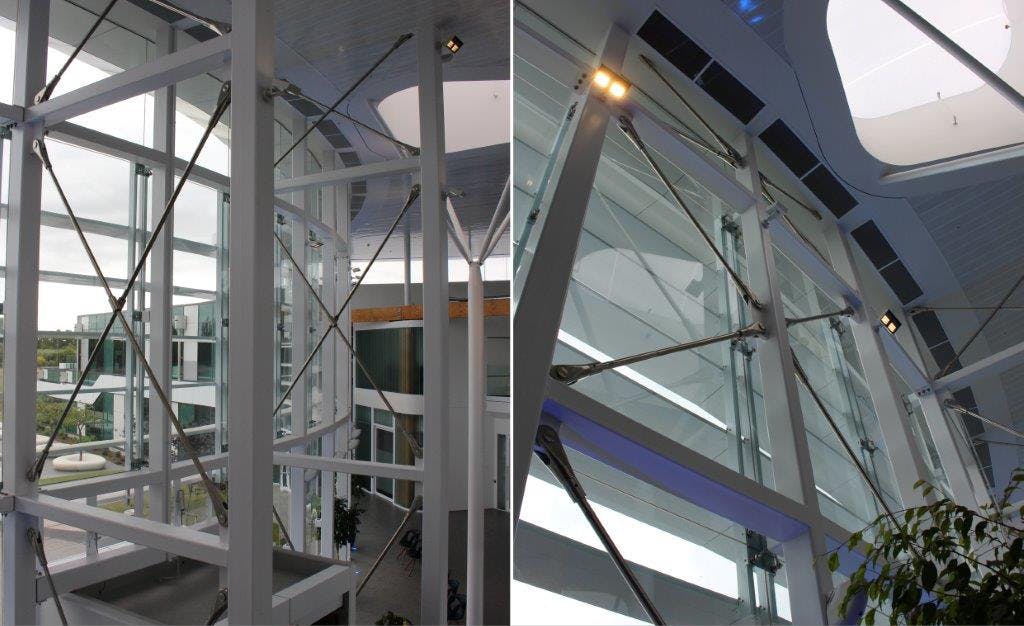
There are two types of Stainless Steel Bracing. Forks are the same for both alternatives but the issue is whether the thread on the rod is rolled or cut.

If the rods, forks and connection plates are supplied by the overseas Manufacturer, the lead time is approximately 3-4 months. Under this option, the threads are rolled and the loads etc. for the full system are advised by the manufacturer.
The sizes range from M6 to M64. The most common diameters are;
If supplied from New Zealand the Rods have Cut threads. The lead time is approximately 2 weeks.
A Registered Engineer needs to confirm that the Loads resulting from Cutting the Threads are acceptable. Materials and Mechanical Test Certificates can be supplied and the calculation of the cut thread stress areas based on the Maryland Metric Thread Data Charts and Newman Tools Thread Data but a responsible Registered Engineer needs to review the Calculations and confirm that the resulting Loads are acceptable for the Design.
Rod supplied in New Zealand is the full "nominal diameter" into which the thread is cut, not the reduced diameter rod supplied by offshore Manufacturers onto which a "dumped up rolled thread" is applied.
The other critical variable is the fact that 316 grade Stainless Steel rod supplied in New Zealand had Yield and UTS in excess of the ex Mill MPa Standard for 316 Stainless Steel. This much higher MPa means that in many cases, it is possible to drop down a diameter even though the thread is being "Cut" to achieve the required Yiel and UTS.
Typically, the maximum rod length is 4.0 meters. Any Stainless Steel brace over 4.0 meters requires a coupler. There are also standard lengths for the amount of threading required for each size of Fork. As brace rods are tensioned by rotating the bar they require a Right Hand Thread one end and a Left Hand Thread the other. To facilitate tension, a Spanner Flat is required at each end.
Duplex 2205 Braces (Forks, Rods and Couplers) and an 560MPa can also be supplied by the overseas manufacturer.
In general terms we use the overseas Manufacturer for large jobs and supply small jobs from New Zealand sourced rod provided the customer gets confirmation from a registered engineer that a "cut thread" solution is acceptable.
Occasionally round central couplers or cross through couplers are requested where the braces cross. Circular central couplers can be Laser Cut in New Zealand. Cross Through couplers are only available in M16 to M64 and only supplied with overseas orders.
Connection flanges must be in-line with the orientation of the brace. They can be laser cut, welded and supplied ex New Zealand.
It is important that the maximum 'slop' between the forks and the connecting flange is 2.0mm.
The minimum thickness of a connection flange is 80% of the gap between the forks. The Fork must locate centrally on the flange, this can be achieved using 316 grade Stainless washers if required.
If the Stainless Steel forks are being connected to any non Stainless Steel flange then care must be taken to ensure the two types of steel are well isolated to ensure no galvanic reaction. View our guide to reducing the risk of corrosion.
Stainless bracing is not intended for applications subject to dynamic loads while Stainless brace components are not suitable for lifting applications.
Click the links below for more info.
FS3A(R) SRS Fork - 316 and FS3B(L) SRS Fork - 316
Note: Anzor can not and does not accept liability for any Bracing System supplied. Anzor are suppliers of Fasteners and are not Architects, Engineers or Quantity Surveyors.
Build Your Deck Faster With Our Decking Screw Calculator
Do it once, do it right with Fischer FBS II Concrete Screw Bolts.
Beat the weather with S2 Cladding Screws.
To be the best, speed matters.
FIS V PLUS 300 T: New chemical formula with 100 years service life
To receive useful info and product updates add your details below